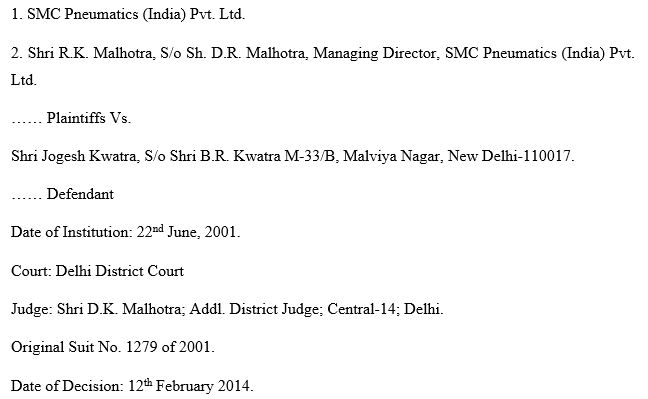![]()

Facts:
Obscene, vulgar, filthy, abusive, intimidating, embarrassing, humiliating, and defamatory e-mails were received by the plaintiff. Using the help of a private computer expert, plaintiff traced one of the e-mails received on 2nd April, 2001. Investigations revealed that the e-mail originated from a Cybercafe in New Delhi. During the enquiry, from a group photograph. The Cybercafe Attendant identified the defendant as the same person who has sent the e-mail.
The e-mails were to the higher officials of the different subsidiaries of SMC worldwide. They have been send through the sales department especially to Australia locate in different countries; where he was as he has worked there and from there forwarded to plaintiff No.2. Copies of e-mails were sent to group companies Managing Directors; only through the Group Companies Managing Directors to defame plaintiff No.2. All these people are deliberately sent copies of the email to poison; their minds and to destroy professional career opportunities and to destabilize the plaintiff.
Plaintiff has come to acquire a copy of all these emails; since these have been forward to the plaintiff. A police complaint is file by the plaintiff against the defendant on 11th May, 2001. On 11th May 2011, the defendant was terminate of the services by the plaintiff; on an accounting of sending the e-mails and harming the plaintiff’s reputation.
Issues
1. Whether the plaintiffs are entitle to relief of perpetual injunctions as prayed in the prayer clause of the plaint? Onus to prove on Plaintiff
2. Whether the plaintiffs have not come to the court with clean hands? Onus to prove on the defendant
3. Relief.
Judgment
Issue 1 decide against the plaintiff because e-mail produce before the court did not qualify as certify evidence under Section 65B of the Indian Evidence Act. Court was not in a position to accept the strongest argument on behalf of the plaintiff under the circumstances in the absence of direct evidence to infer that it was the defendant, in particular, that person who was sending those emails.
Issue 2 was called off as infructuous because there were no specific pleadings except the general objection based on factors that will determine whether the plaintiff has any cause of action or not.
Issue 3 was dismissed keeping in mind the facts and circumstances of the case.
Case Analysis
A written statement was filed by the defendant in which it was submitted that the plaintiffs have not come to this court with clean hands and that the allegations leveled by the plaintiffs against the defendant are false and fabricated as is evident from the fact that the plaintiffs have miserably failed to:
- Furnish the server from which each of the emails originated
- The time of origin of each of the alleged emails
- The details of the Internet connection of the author of emails such as the user name
- The telephone number used to connect to the originating server and the telephone number dialed for connecting to the originating server or in case the author sender of emails has used a leased line.
- Complete details of such leased line.
Replication was filed by the plaintiffs wherein they rejected the allegations of the written statement made by the defendant and reiterated and reaffirmed the contents of the plaint.
Six witnesses were called from the side of the plaintiff counsel. Secretary of Plaintiff No.2 and employee of plaintiff No. 1, Plaintiff No. 2 himself, Director Operations in the plaintiff No.1, Dy. Divisional Manager (Accounts & Administration) in the plaintiff No.1 Company, Computer Expert, and Forensic Expert/Handwriting Expert.
One witness was called from the side of the defendant counsel. Defendant himself.
According to the Specific Relief Act, if the plaintiff has not come to court with clean hands, he is not entitled to perpetual injection.
Of all the e-mails received only one was traced. The e-mail was traced to Cybercafe. The identity of Cybercafe was used for sending the e-mail and not of the person sending the e-mail. The Cybercafe Attendant identified the defendant from a photograph of a picnic, but that photograph has not be presented in the records.
The argument of the plaintiff counsel was not that these e-mails were traced to the defendant’s ID, but was that the contents of e-mails were such that shows the author of the e-mail was defendant, because the raised issues were orally discussed by defendant with the management especially with plaintiff no. 2.
The plaintiff counsel also pointed out that after the interim injunction was passed those kinds of e-mails stopped arriving except once. Therefore, according to the plaintiff counsel defendant was the person doing the activity and he was injuncted so he stopped it so that he does not have to face the consequences for not obeying the court.
Conclusion
This case gave birth to a new term ‘cyber defamation’ in the Indian law as it was the first case of cyber defamation in India, so it holds a lot of significance. New angles were explored under this case which was never explored before in any Indian court. This case holds acts as a base for cyber defamation in India.



0 Comments